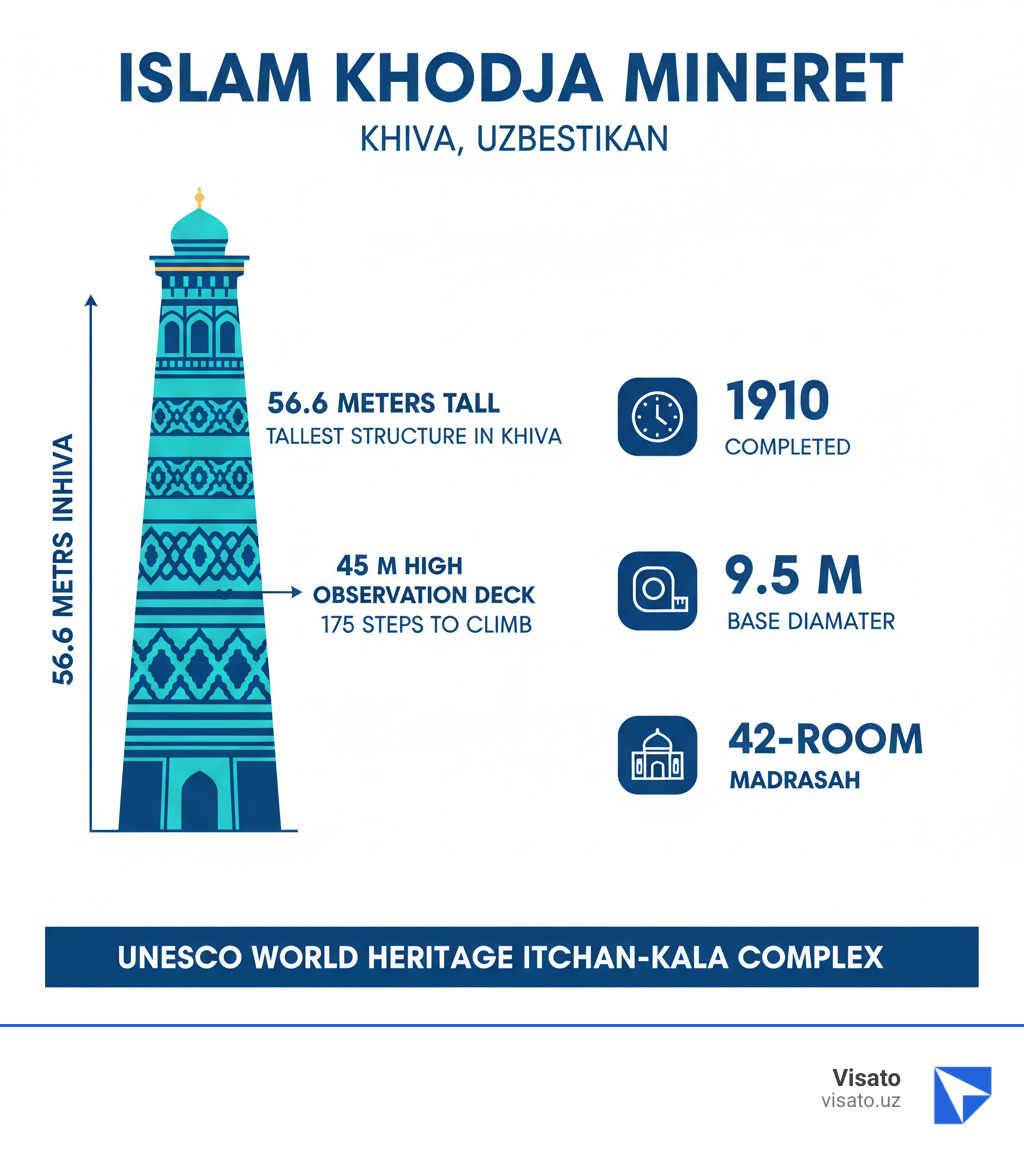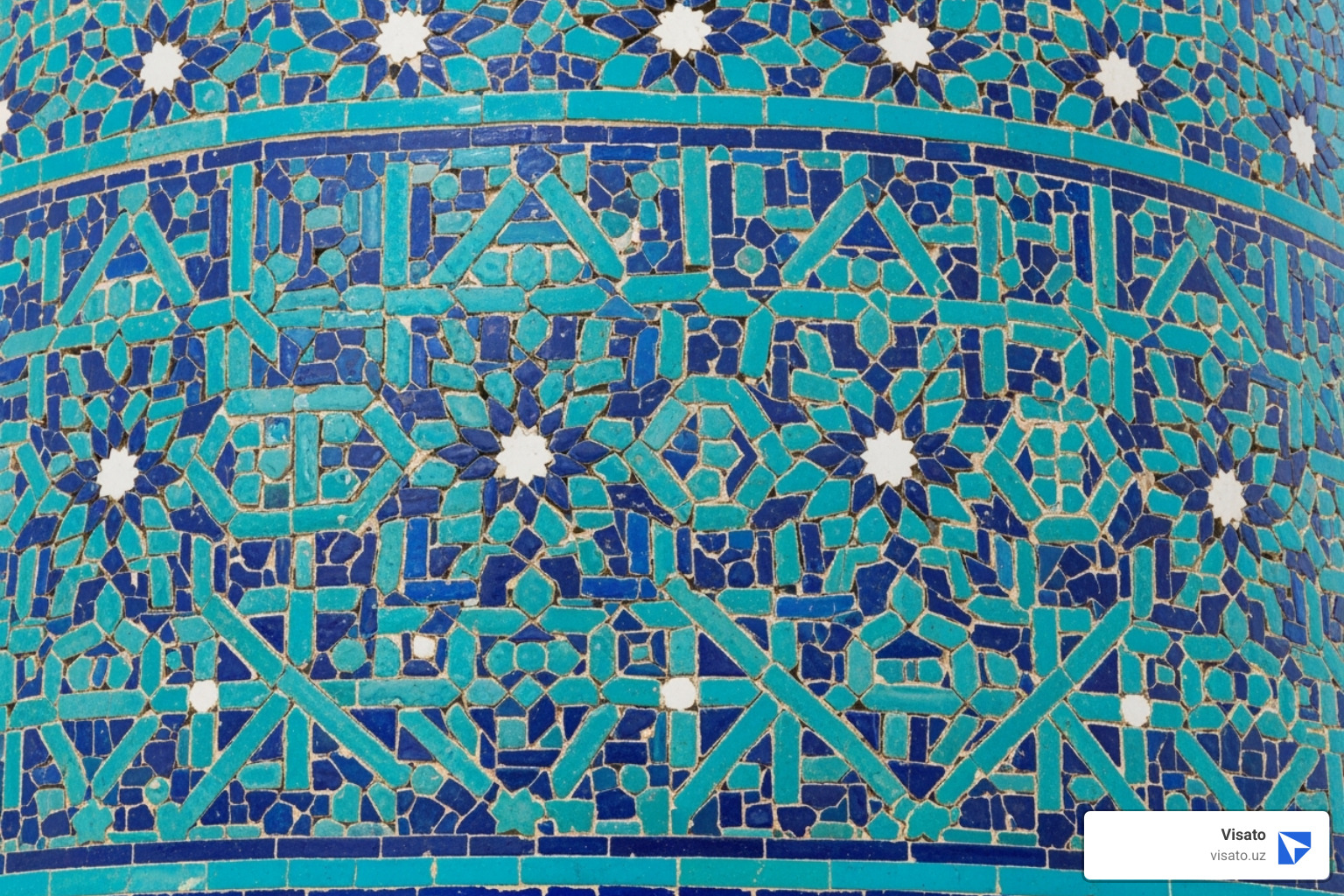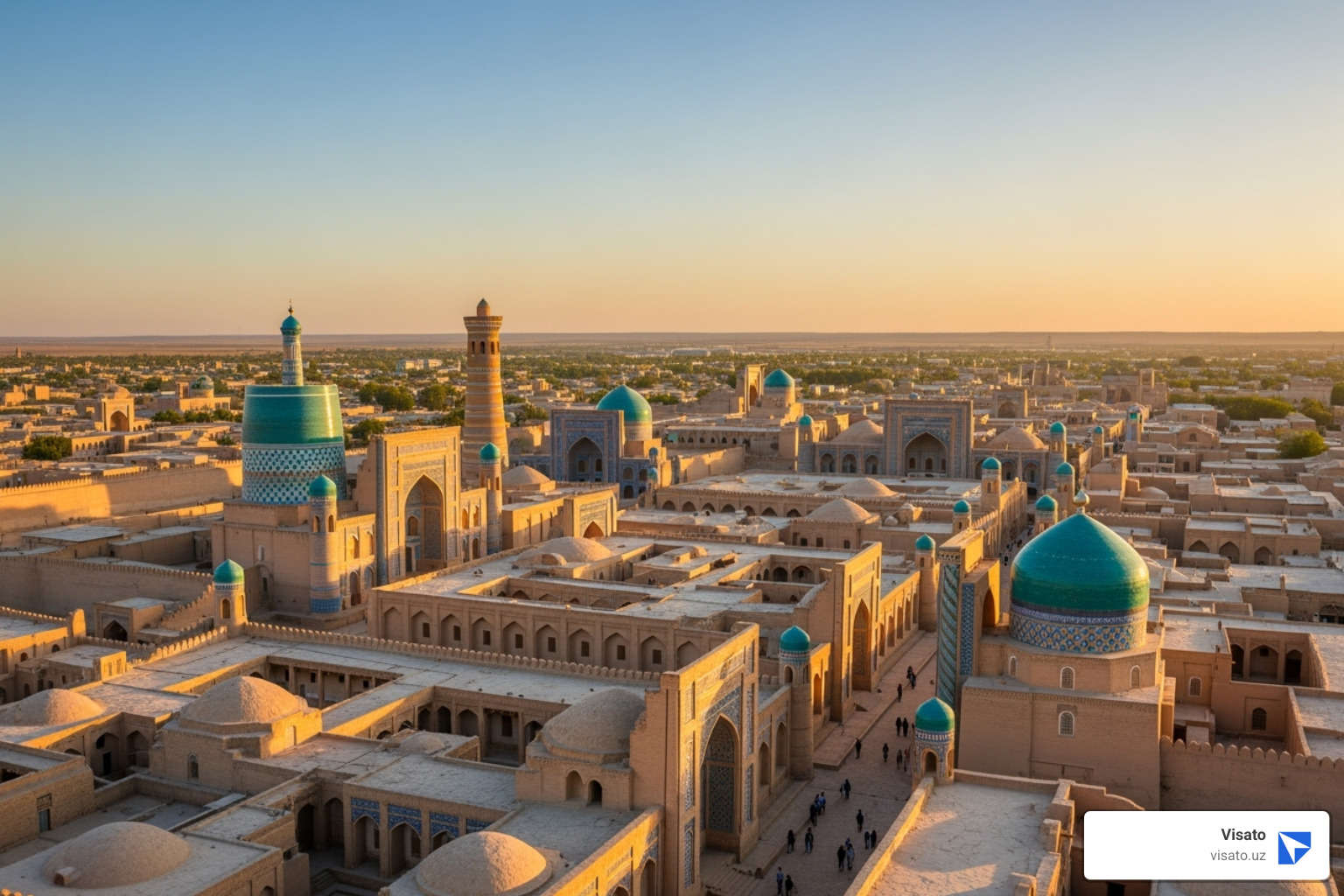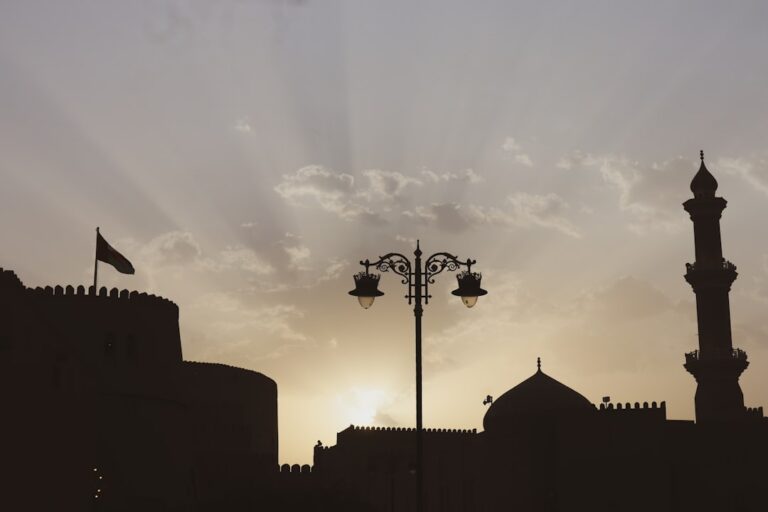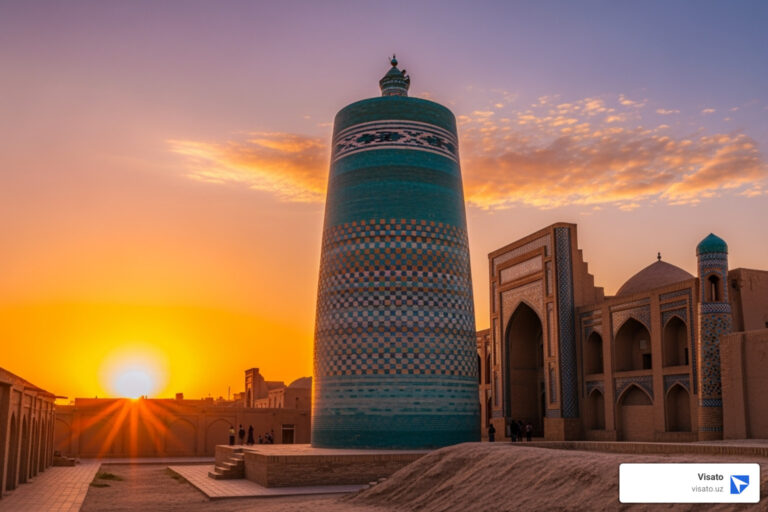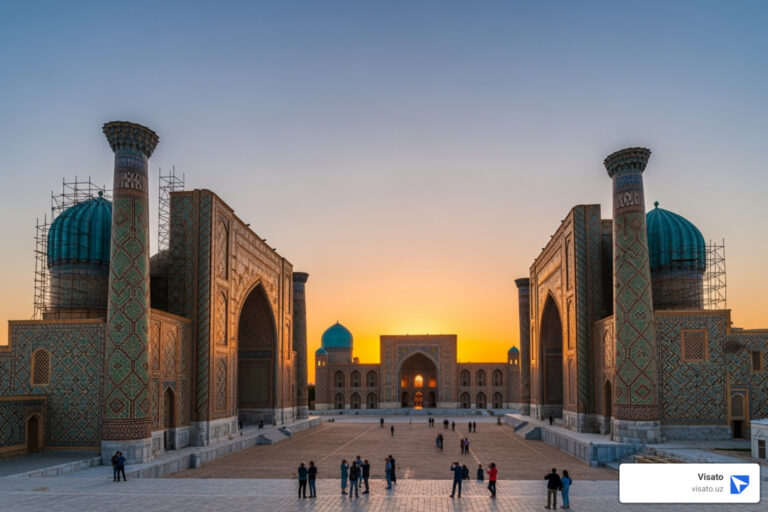A Symbol of Khiva: An Introduction to the Islam Khodja Minaret
The Islam Khodja Minaret is the tallest minaret in Khiva, Uzbekistan, standing at 56.6 meters (185 feet) and serving as the city’s most recognizable landmark. Built from 1908-1910, this masterpiece dominates the skyline of Itchan-Kala, the historic inner city and Uzbekistan’s first UNESCO World Heritage Site (1990).
Quick Facts about the Islam Khodja Minaret:
- Height: 56.6 meters (185 feet)
- Base Diameter: 9.5 meters
- Construction Completed: 1910
- Steps to Top: 175 steep, narrow stairs
- Observation Deck Height: 45 meters
- Status: Tallest minaret in Khiva
- Current Use: Viewpoint and part of a museum complex
Commissioned by Islam Khoja, the progressive prime minister of Isfandiyar Khan, the minaret is part of a complex that includes Khiva’s smallest madrasah. Khoja also established the city’s first hospital, post office, and secular school. The design creates a deliberate contrast between the soaring tower and the modest madrasah.
Much like the Eiffel Tower in Paris, the Islam Khodja Minaret is Khiva’s defining monument. Its slender, tapering form is adorned with horizontal bands of glazed tiles in azure, turquoise, white, and dark blue, showcasing the skill of early 20th-century Khorezm artisans.
I’m Nariman Huseynov from Visato, where I’ve spent over 5 years helping international travelers steer visa requirements for destinations like Uzbekistan, home to the stunning Islam Khodja Minaret. Our team has assisted thousands of visitors in experiencing Central Asia’s architectural treasures with quick, secure e-visa processing.
A Visionary’s Legacy: The History Behind the Tower
The Islam Khodja Minaret tells the story of a man who dreamed of a modern Khiva and paid the ultimate price for his vision.
Islam Khoja, Grand Vizier to Isfandiyar Khan, was a progressive leader who looked beyond Khiva’s ancient walls. He studied European developments and believed his homeland could modernize without losing its soul. He turned ideas into reality, establishing Khiva’s first hospital, a modern post office and telegraph office, and a European-style secular school. These reforms connected the ancient city to the wider world and offered education beyond traditional religious instruction.
These changes were radical for the deeply traditional society. The conservative clergy and nobility saw his reforms not as progress, but as a threat to the established order, leading to growing opposition and resentment.
Just three years after his minaret was completed, Islam Khoja was assassinated in 1913. His death was a stark reminder of the resistance to change, yet the tower he commissioned still stands as a 56.6-meter testament to his vision. Completed in 1910, the minaret was a statement that Khiva could stand tall among the great cities of the East. You can explore more about the historical context on the Islamkhodja Madrasah Wikipedia page.
The Islam Khodja Complex
The Islam Khodja Minaret is part of a thoughtfully designed ensemble that includes the Islam Khodja Madrasah. The architects created a brilliant architectural contrast by pairing Khiva’s tallest structure with its smallest madrasah. The soaring minaret draws the eye skyward, while the modest madrasah grounds the complex.
The madrasah’s 42 hujras (student rooms) once housed scholars. Today, the building is home to the Museum of Applied Arts, showcasing the craftsmanship of Khorezm artisans through exhibits of embroidery, metalwork, and tile decoration. The complex also includes a peaceful courtyard and a small mosque with a beautifully decorated mihrab (prayer niche). The varying building sizes create a harmonious and dynamic ensemble. For a deeper look at this architectural gem, visit The architectural ensemble of Khodja Islam on Uzbekistan Travel’s official site.
An Architectural Marvel: Design and Decoration
The Islam Khodja Minaret is a symphony of form and decoration, representing the pinnacle of early 20th-century Khorezmian architecture. Standing 56.6 meters tall with a 9.5-meter base, its graceful height is improved by a tapering design that creates a visual illusion of being even taller and more slender.
The design pays homage to earlier Central Asian minarets while incorporating the ambitions of 1910. The foundation is traditional brickwork, but the surface is adorned with horizontal bands of glazed tiles that spiral upward. These bands alternate with unglazed brick, creating a textured effect that changes with the light.
Near the top, a stalactite cornice (sharafa) provides a graceful transition to the upper chamber. Above this, a ceramic lattice (pandjara) allows light and air to filter in, all crowned by a small dome. The observation deck at 45 meters is the culmination of this journey, integrating structural integrity with decorative artistry. The minaret draws on 14th-century architectural influences while using contemporary innovations, bridging historical tradition and modern ambition.
The Significance of the Tilework
The minaret’s tilework transforms it into a work of art. The color palette is dominated by azure, dark blue, white, and turquoise, shades with deep symbolism in Islamic art. Blue represents the heavens, while turquoise evokes paradise. Against Khiva’s sky, these colors create a stunning dialogue between earth and heaven.
The glazed tiles are arranged in intricate geometric patterns and stylized calligraphy, designed to guide the eye skyward. Bands of sparkling glazed tile (majolica) alternate with earthy, unglazed brickwork, creating a rhythmic, textured pattern. This contrast comes alive in the shifting light, especially during the golden hour when the tiles seem to glow.
This level of Khorezm craftsmanship required mastery of both ceramic production and artistic design, representing centuries of accumulated knowledge. Each tile connects the Islam Khodja Minaret to a long tradition of Central Asian artistic excellence. Planning your journey to see this wonder requires some preparation. Understanding travel requirements ensures your visit goes smoothly. For details on entry requirements, check our guide. More info about Uzbekistan e-visa requirements
The Climb to the Top: The Visitor Experience
Climbing the Islam Khodja Minaret is an unforgettable experience that connects you with Khiva’s history, but be prepared for a workout. The ascent involves approximately 175 steep, narrow steps up a traditional narrow spiral staircase. This physical exertion is demanding, and the confined space can be challenging for those with claustrophobia or mobility issues.
Every step is worth it. The reward is the observation deck at 45 meters, which offers breathtaking panoramic views. Below you lies the maze of Itchan-Kala: narrow streets, adobe houses, gleaming mosque domes, and the formidable fortress walls. Beyond the walls, the desert stretches to the horizon, highlighting the city’s magnificent existence. From this vantage point, you can spot other landmarks and understand Khiva’s layout in a way that’s impossible from the ground.
Planning Your Visit to the Islam Khodja Minaret
Strategic planning can make your visit unforgettable. For the best times for photography, aim for the golden hour (sunrise or sunset). The low-angle light makes the tiles and brickwork glow.
To avoid crowds and midday heat, plan for an early morning or late afternoon visit. This is especially important during Khiva’s hot summers. For practical tips, wear comfortable shoes with good grip for the uneven steps. Hydration is crucial, so carry water, and don’t forget sun protection like a hat and sunscreen.
Be realistic about your fitness level. The climb requires stamina. If you have mobility concerns or severe claustrophobia, admiring the minaret from the ground is still a wonderful experience. After your descent, explore the Islam Khodja Madrasah and its Museum of Applied Arts. Before you go, you’ll need to sort out your travel documents. Planning your trip starts with the visa process. Get your Uzbekistan e-visa guide to begin your journey.
Khiva’s Crown Jewel: A Regional Comparison
The Islam Khodja Minaret was a bold architectural statement. Commissioned in the early 20th century, the ambitious goal was to create a structure that would surpass Bukhara’s legendary Kalyan Minaret. They succeeded. At 56.6 meters, the Islam Khodja Minaret eclipses Bukhara’s 48-meter Kalyan Minaret. Beyond height, it represents an architectural evolution. While the Kalyan Minaret has medieval grandeur, the Islam Khodja Minaret offers a refined, slender elegance with vibrant tilework reflecting early 1900s aesthetics.
As the tallest in Khiva, the minaret is the city’s compass, visible across the city and serving as a landmark for travelers. For centuries, it has guided people toward Khiva through the desert. Even today, it’s a reliable guide if you get lost in the old city’s maze-like streets.
The Unfinished Rival: Kalta Minor
Within Khiva, the Islam Khodja Minaret has a fascinating companion: the Kalta Minor Minaret. Commissioned in 1855, it was intended to be over 70 meters tall but unfinished construction stopped abruptly at 26 meters, likely due to the patron’s death. Despite its short stature, Kalta Minor is a beloved landmark, famous for its complete covering of stunning unique turquoise tiling. It stands as a beautiful, incomplete dream next to the realized vision of the Islam Khodja Minaret. Together, they define Khiva’s unique skyline.
As you plan your visit to see these wonders, keeping track of your travel documents is key. You can easily check your Uzbekistan e-visa application status to ensure you’re ready for your journey.
Frequently Asked Questions about the Islam Khodja Minaret
Here are answers to the most frequently asked questions about the Islam Khodja Minaret to help you plan your visit.
How tall is the Islam Khodja Minaret?
The Islam Khodja Minaret stands at an impressive 56.6 meters (185 feet), making it the tallest in Khiva and taller than the Kalyan Minaret in Bukhara. The observation deck is at 45 meters, offering panoramic views over Itchan-Kala.
Can you climb the Islam Khodja Minaret?
Yes, you can climb the minaret via approximately 175 narrow steps. It’s a strenuous workout in a tight spiral staircase, but the rewarding panoramic views are worth it. Due to the confined space and steepness, the climb is not for those with claustrophobia or mobility issues.
What is the entrance fee for the Islam Khodja Minaret?
Access is typically included with the general Itchan-Kala entrance ticket, which covers most monuments in the walled city. However, policies can change, so it’s always best to confirm locally upon arrival.
As you plan these details, getting your travel documents sorted is the first step. We make the visa process straightforward so you can focus on the exciting parts of your trip. If you haven’t started, you can apply for your Uzbekistan e-visa today!
Your Journey to Khiva’s Skies
Standing before the Islam Khodja Minaret, you witness the bold dream of Islam Khoja, a man who dared to modernize his world. His vision lives on in this soaring tower, a reminder that progress and tradition can create something extraordinary together. The minaret’s story goes beyond its height, speaking of a progressive leader, showcasing the skill of Khorezmian artisans, and offering climbers unforgettable views that connect them to centuries of Silk Road history.
The Islam Khodja Minaret is a must-see in Uzbekistan. The experience of standing atop Khiva’s tallest structure, gazing over the ancient city, is truly special.
At Visato, we believe planning your journey should be as smooth as your eventual climb. We’ve helped thousands of travelers experience Uzbekistan’s treasures by making the e-visa process fast, simple, and stress-free. Our secure platform delivers your e-visa in as little as 2-3 business days, with 24/7 support.
Your adventure to Khiva’s skies is waiting. Don’t let visa paperwork delay your journey to one of Central Asia’s most breathtaking landmarks. Apply for your Uzbekistan e-visa today!

